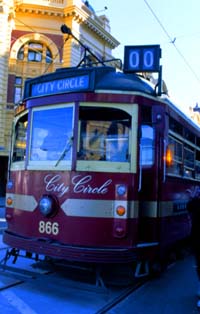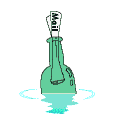Queen Victoria Market
Queen Victoria Market is the biggest flea market in town (and maybe the country) is held on Sundays 9 AM–4 PM at the Queen Victoria Market. Starting in the wee hours on Tuesday, Thursday, Friday, and Saturday mornings, it's a fresh produce and fruit market. It is one of the most popular tourist attraction in Melbourne. For the uniniated it is hard to know where to start as the range of produce and merchandise is so great. This is because the Queen Victoria Market is both a fresh produce market and a clothes and bric a brac emporium. In the fresh produce section there is an amazing array of fruit and vegetables plus an extensive delicatessen section where you can find anything from dolmades and fresh pasta, to gefilte fish and tapas.
Built on what was Melbourne’s first general cemetery, visitors to the Vic Market — as locals call it — are walking over the graves of such luminaries as Melbourne's founding father, John Batman. One thing's for sure: after visiting The Vic Market you’ll be physically and emotionally satiated.
Royal Melbourne Zoo
The Melbourne Zoo is a very historic site to Melbourne. It is Australia's oldest zoo and the 11th oldest in the world. On 6 October,1999 the Melbourne Zoo celebrated it's 134th birthday.
The Melbourne Zoo is a must see for anyone who likes nature, its animals and its environment. The Melbourne Zoo’s aim is to create living conditions as close as possible to those that the animal experiences in the wild. Visitors can enjoy the varied life of the African Rainforest, the Asian Rainforest and the Australian Bush. Whether it be the gorillas (some of whom have been bred in the Zoo), the big cat enclosure or the joy of seeing hippopotamus swim by from the glass viewing area, Melbourne Zoo provides a window into the world of the 350 animal species that it houses. Orang-utans, otters, meekats and penguins all have their own feeding times where visitors can appreciate the wonderful eating habits of the wild.
Melbourne Zoo is set in Royal Park amongst 22 hectares of botanic garden just 4km from the city. Visiting the butterfly house is a must. Here you can walk through a large glass hothouse which is home to about 12 species of Australian tropical butterflies. The Great Flight Aviary provides a similar experience with rainforest, wetland or dry woodland birds circling this huge domed enclosure.
Spending a day in the Melbourne Zoo can mean an experience of a lifetime.
The Zoo is a place where people can learn about nature and animals, be entertained by the performers or just have a nice relaxing afternoon with the animals. Whatever choice you make, the zoo is guaranteed to be entertaining for the whole family.
A view of the Zoo
Melbourne's Tram
 Melbourne's tram system began operations in 1885, when the first cable line operated by the Melbourne Tramway and Omnibus Company opened for business. The cable tram system grew to be very comprehensive and operated successfully for 55 years.
Melbourne's tram system began operations in 1885, when the first cable line operated by the Melbourne Tramway and Omnibus Company opened for business. The cable tram system grew to be very comprehensive and operated successfully for 55 years.
Electric trams
Australia's first electric tram line was built by a group of land developers using equipment left over from the Great Exhibition of 1888.
After the Second World War, when all that was shiny and new (like the motor car) was embraced, and all that was established and old-fashioned (like the tram) was rejected, Melbourne alone stood against the tide. Sir Robert Risson, far from having a taste for tramway closures, stoutly defended the trams against a hostile press. He upgraded track by setting it in mass concrete (when this was still politically possible) and even the Government could see that removing trams would be a waste of the investment.
He argued that trams would always attract more patronage than an equivalent bus service, and proved it in 1956 when the Bourke St bus service (which had replaced a cable tram line) was upgraded to a tram in time for the Olympic games, despite the wailing of the newpapers. Another factor in Melbourne's favour that is often mentioned is the wide main streets, which meant that there was less obstruction of cars than in other cities. By the mid 1970s, Melbourne could see how lucky she had been not to follow the fashions of the '50s, and even the conservative government, normally given to starving public transport to death, agreed to the purchase of new trams.
If you have any suggestions or questions email me:

 Melbourne's tram system began operations in 1885, when the first cable line operated by the Melbourne Tramway and Omnibus Company opened for business. The cable tram system grew to be very comprehensive and operated successfully for 55 years.
Melbourne's tram system began operations in 1885, when the first cable line operated by the Melbourne Tramway and Omnibus Company opened for business. The cable tram system grew to be very comprehensive and operated successfully for 55 years.
